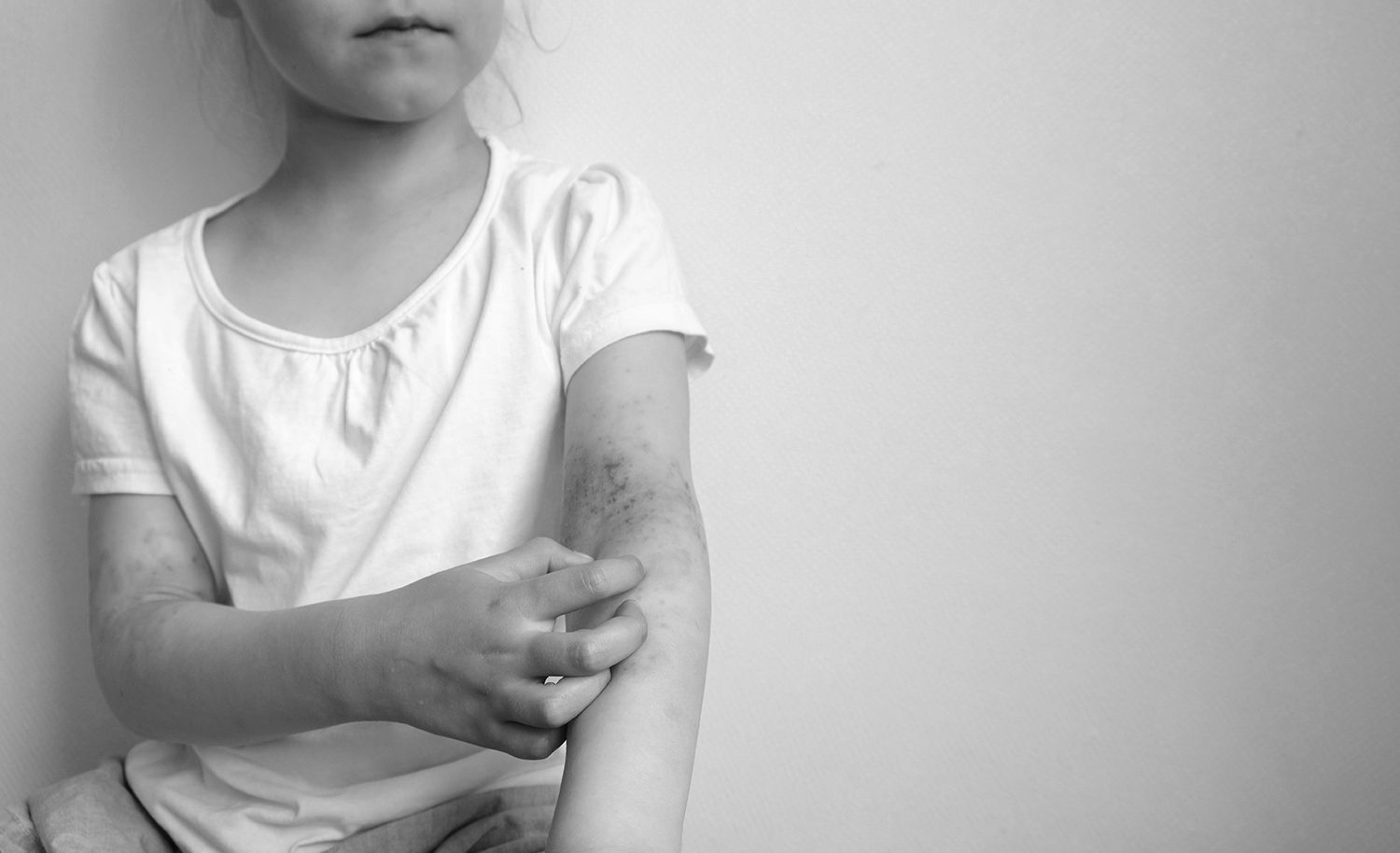Extended Half-life Antibodies: The Future of Biologic Therapy in Atopic Dermatitis?

Featured Student: Yeanna Moon
Yeanna Moon is a fourth-year student in the B.A./M.D. Program at the University of Missouri-Kansas City with an interest in dermatology and a strong commitment to addressing health care equities. Her academic interests like at the intersection of clinical dermatology, basic science, and public health, with ongoing work in translational research and advocacy. Outside of her studies, she finds balance through music, volunteering and exploring new coffee shops.
Introduction
Biologics have dramatically transformed the care of atopic dermatitis (AD) in the past decade and raised the bar for a new standard of care for many patients. However, they have some important limitations. One sizable limitation is that they require injections with fairly high frequency, currently from every 2-4 weeks initially. Excitingly, the most recent addition to the armamentarium offers an extended 8-week dosing schedule for patients who have achieved an adequate clinical response.1 However, the future holds the possibility for far fewer injections: new technologies are making once- or twice-yearly injections a true possibility, opening up biologic therapy in a whole new way.1
While biologics have revolutionized AD treatment, their administration presents several challenges that can increase patient burden and healthcare costs. Needle phobia, affecting approximately 24% of adults and 63% of children, leads to immunization non-compliance in 7% and 8% of these groups, respectively, potentially resulting in treatment avoidance and compromised disease management.2,3 In particular, children exhibit higher rates of needle phobia, with studies indicating that 63% of those aged 6-17 years experience this anxiety.3 Additionally, many biologic medications require strict refrigeration between 2°C and 8°C to maintain efficacy, posing significant challenges for patients who travel or lack consistent access to refrigeration. Maintaining the cold chain during transport is both costly and logistically complex. Studies have shown that over 80% of patients inadvertently expose their biologic therapies to temperatures outside the recommended range, which can compromise the effectiveness of treatment and negatively impact patient outcomes.4 Addressing these issues is crucial to enhance patient adherence, reduce healthcare costs, and improve overall treatment outcomes for individuals with AD.
Current Therapies
Several biologic therapies are currently available for AD, each targeting key inflammatory pathways with varying dosing schedules and pharmacokinetics. Dupilumab, the first approved biologic, inhibits IL-4 and IL-13 signaling through IL-4Rα and is administered every other week in adults after a loading dose, and has a half-life of approximately 14 days (Note: the elimination is non-linear and depends on factors such as age, weight, and concentration).5 IL-13 inhibitors lebrikizumab and tralokinumab follow similar regimens, with initial dosing every 2 weeks and then maintenance doses every 4 weeks and exhibit half-lives of 25 and 18 days, respectively.6,7 Nemolizumab, targeting IL-31, with a half-life of 19 days, is given every four weeks initially with possible maintenance doing at 8 week intervals.8 Newer OX40-targeting biologics Amlitelimab, Telazorlimab, and Roxatinlimab, are currently in clinical trials phase 2b, 2b, and 3 respectively. Amlitelimab is dosed every two weeks and has a 24-day half-life while Telazorlimab has a median half-life of 10–15 days.9,10 Rocatinlimab is given every four weeks, with a half-life of approximately 17 days.11 Despite their effectiveness, the frequent injection schedules required for these biologics remain a significant barrier to patient adherence and long-term success.
Challenges of Frequent Injections
Frequent injection schedules for biologic therapies in AD can pose challenges to patient adherence. A study on biologic treatments for severe asthma, a condition that like AD often requires regular injections, found that only 54% of patients treated with dupilumab achieved an adherence rate of 75% or higher, suggesting that the frequency of injections may impact adherence rates.12 Additionally, studies have demonstrated that extending dosing intervals for biologics in AD can reduce the number of injections, potentially improving patient adherence and satisfaction.1 These findings highlight the importance of developing biologic therapies with extended dosing intervals to enhance treatment adherence and patient outcomes in AD.
New Technologies
Emerging technologies focused on extending antibody half-life aim to address this challenge by reducing the frequency of injections, with the potential to decrease the need for injections to nearly twice a year. One promising approach involves optimizing antibody interactions with the neonatal Fc receptor (FcRn). By modifying the Fc region of monoclonal antibodies, their affinity for FcRn is enhanced, allowing for increased recycling and reduced degradation (Figure 1). This approach is exemplified by extended half-life biologics like APG777, an IL-13 inhibitor with a half-life of approximately 75 days, far surpassing the 18-day half-life of lebrikizumab.6,13,14 Similarly, IMG-007, an OX40 inhibitor, utilizes FcRn-based modifications to extend its presence in circulation, reducing the need for frequent dosing.13
Alternative methods for extending antibody half-life include PEGylation and albumin binding. PEGylation involves attaching polyethylene glycol (PEG) chains to therapeutic proteins, increasing their molecular size and reducing renal clearance (Figure 1).15 While PEGylation can improve pharmacokinetic properties, it may also lead to immunogenic responses, including the development of anti-PEG antibodies, which can accelerate drug clearance.16 Another approach, albumin binding, involves genetic fusion of therapeutic proteins to human serum albumin or chemical conjugation to albumin-binding domains. This approach leverages albumin's long circulation time to enhance the persistence of therapeutic antibodies, potentially reducing dosing frequency (Figure 1).17 These technologies aim to improve pharmacokinetics and enhance patient adherence by reducing the need for frequent injections.
Conclusion
The development of extended half-life biologics represents a transformative shift in the treatment of atopic dermatitis.13 Currently, biologics require frequent injections, which can be burdensome for patients and hinder long-term treatment success. However, the advent of technologies such as FcRn optimization, PEGylation, and albumin binding promises to reduce injection frequency to just once or twice per year. This groundbreaking shift will not only alleviate the burden of frequent clinic visits and injections but also improve patient convenience, adherence, and overall satisfaction with treatment. As these technologies evolve, they hold the potential to revolutionize biologic therapy for AD and other chronic inflammatory diseases, offering a more sustainable and accessible treatment paradigm that could reshape the future of care and management for these conditions. This breakthrough represents a major leap forward in chronic disease treatment, making therapies more accessible and sustainable for patients.
References:
- Jacobson ME, Boesjes CM, de Bruin-Weller MS, de Graaf M, Morimoto RY, Simpson EL. Increasing dosing intervals for biologics in atopic dermatitis-why, who, when and how? J Eur Acad Dermatol Venereol. 2025 Jan 22. doi: 10.1111/jdv.20534. Epub ahead of print. PMID: 39840710.
- Taddio A, Ipp M, Thivakaran S, Jamal A, Parikh C, Smart S, Sovran J, Stephens D, Katz J. Survey of the prevalence of immunization non-compliance due to needle fears in children and adults. Vaccine. 2012 Jul 6;30(32):4807-12. doi: 10.1016/j.vaccine.2012.05.011. Epub 2012 May 19. PMID: 22617633.
- Orenius T, LicPsych, Säilä H, Mikola K, Ristolainen L. Fear of Injections and Needle Phobia Among Children and Adolescents: An Overview of Psychological, Behavioral, and Contextual Factors. SAGE Open Nursing. 2018;4. doi:10.1177/2377960818759442
- Yu YB, Briggs KT, Taraban MB, Brinson RG, Marino JP. Grand Challenges in Pharmaceutical Research Series: Ridding the Cold Chain for Biologics. Pharm Res. 2021 Jan;38(1):3-7. doi: 10.1007/s11095-021-03008-w. Epub 2021 Feb 8. PMID: 33555493; PMCID: PMC7869771.
- Le Floc'h A, Allinne J, Nagashima K, Scott G, Birchard D, Asrat S, Bai Y, Lim WK, Martin J, Huang T, Potocky TB, Kim JH, Rafique A, Papadopoulos NJ, Stahl N, Yancopoulos GD, Murphy AJ, Sleeman MA, Orengo JM. Dual blockade of IL-4 and IL-13 with dupilumab, an IL-4Rα antibody, is required to broadly inhibit type 2 inflammation. Allergy. 2020 May;75(5):1188-1204. doi: 10.1111/all.14151. Epub 2020 Jan 3. PMID: 31838750; PMCID: PMC7317958.
- Andrew Blauvelt, Jacob P Thyssen, Emma Guttman-Yassky, Thomas Bieber, Esther Serra-Baldrich, Eric Simpson, David Rosmarin, Hany Elmaraghy, Eric Meskimen, Chitra R Natalie, Zhuqing Liu, Chenjia Xu, Evangeline Pierce, MaryAnn Morgan-Cox, Esther Garcia Gil, Jonathan I Silverberg, Efficacy and safety of lebrikizumab in moderate-to-severe atopic dermatitis: 52-week results of two randomized double-blinded placebo-controlled phase III trials, British Journal of Dermatology, Volume 188, Issue 6, June 2023, Pages 740–748, https://doi.org/10.1093/bjd/ljad022
- Ratnarajah K, Le M, Muntyanu A, et al. Inhibition of IL-13: A New Pathway for Atopic Dermatitis . Journal of Cutaneous Medicine and Surgery. 2020;25(3):315-328. doi:10.1177/1203475420982553
- Serra-Baldrich E, Santamaría-Babí LF, Francisco Silvestre J. Nemolizumab: An Innovative Biologic Treatment to Control Interleukin 31, a Key Mediator in Atopic Dermatitis and Prurigo Nodularis. Actas Dermosifiliogr. 2022 Jul-Aug;113(7):674-684. English, Spanish. doi: 10.1016/j.ad.2021.12.014. Epub 2021 Dec 23. PMID: 35842249.
- Saghari M, Gal P, Gilbert S, Yateman M, Porter-Brown B, Brennan N, Quaratino S, Wilson R, Grievink HW, Klaassen ES, Bergmann KR, Burggraaf J, van Doorn MBA, Powell J, Moerland M, Rissmann R. OX40L Inhibition Suppresses KLH-driven Immune Responses in Healthy Volunteers: A Randomized Controlled Trial Demonstrating Proof-of-Pharmacology for KY1005. Clin Pharmacol Ther. 2022 May;111(5):1121-1132. doi: 10.1002/cpt.2539. Epub 2022 Mar 1. PMID: 35092305; PMCID: PMC9314635.
- Rewerska B, Sher LD, Alpizar S, Pauser S, Pulka G, Mozaffarian N, Salhi Y, Martinet C, Jabert W, Gudi G, Ca V, Gn S, Macoin J, Anstett V, Turrini R, Doucey MA, Blein S, Konto C, Machkova M. Phase 2b randomized trial of OX40 inhibitor telazorlimab for moderate-to-severe atopic dermatitis. J Allergy Clin Immunol Glob. 2023 Nov 22;3(1):100195. doi: 10.1016/j.jacig.2023.100195. PMID: 38187863; PMCID: PMC10770725.
- Guttman-Yassky, E., Simpson, E., Bissonnette, R., Eichenfield, L. F., Kabashima, K., Luna, P. C., Kricorian, G. (2025). ROCKET: a phase 3 program evaluating the efficacy and safety of rocatinlimab in moderate-to-severe atopic dermatitis. Immunotherapy, 17(2), 83–94. https://doi.org/10.1080/1750743X.2025.2464528
- Real-world severe asthma biologic administration and adherence differs by biologic
- Ledford, Dennis K. et al. Annals of Allergy, Asthma & Immunology, Volume 131, Issue 5, 598 - 605.
- Yilmaz, O., Torres, T. Extended Half-life Antibodies: A Narrative Review of a New Approach in the Management of Atopic Dermatitis. Dermatol Ther (Heidelb) 14, 2393–2406 (2024). https://doi.org/10.1007/s13555-024-01253-6
- Binder, U., & Skerra, A. (2024). Strategies for extending the half-life of biotherapeutics: successes and complications. Expert Opinion on Biological Therapy, 25(1), 93–118. https://doi.org/10.1080/14712598.2024.2436094
- Batra J, Robinson J, Mehner C, et al. PEGylation extends circulation half-life while preserving in vitro and in vivo activity of tissue inhibitor of metalloproteinases-1 (TIMP-1). PloS One. 2012;7(11):e50028.
- Chapman AP. PEGylated antibodies and antibody fragments for improved therapy: a review. Adv Drug Deliv Rev. 2002 Jun 17;54(4):531-45. doi: 10.1016/s0169-409x(02)00026-1. PMID: 12052713.
- Tan, H., Sattler, M., & Zou, P. (2024). Albumin-binding as a universal strategy for half-life extension. Journal of Biopharmaceutical Sciences, 1(1), 1-9. https://doi.org/10.33425/2690-8077.1043



